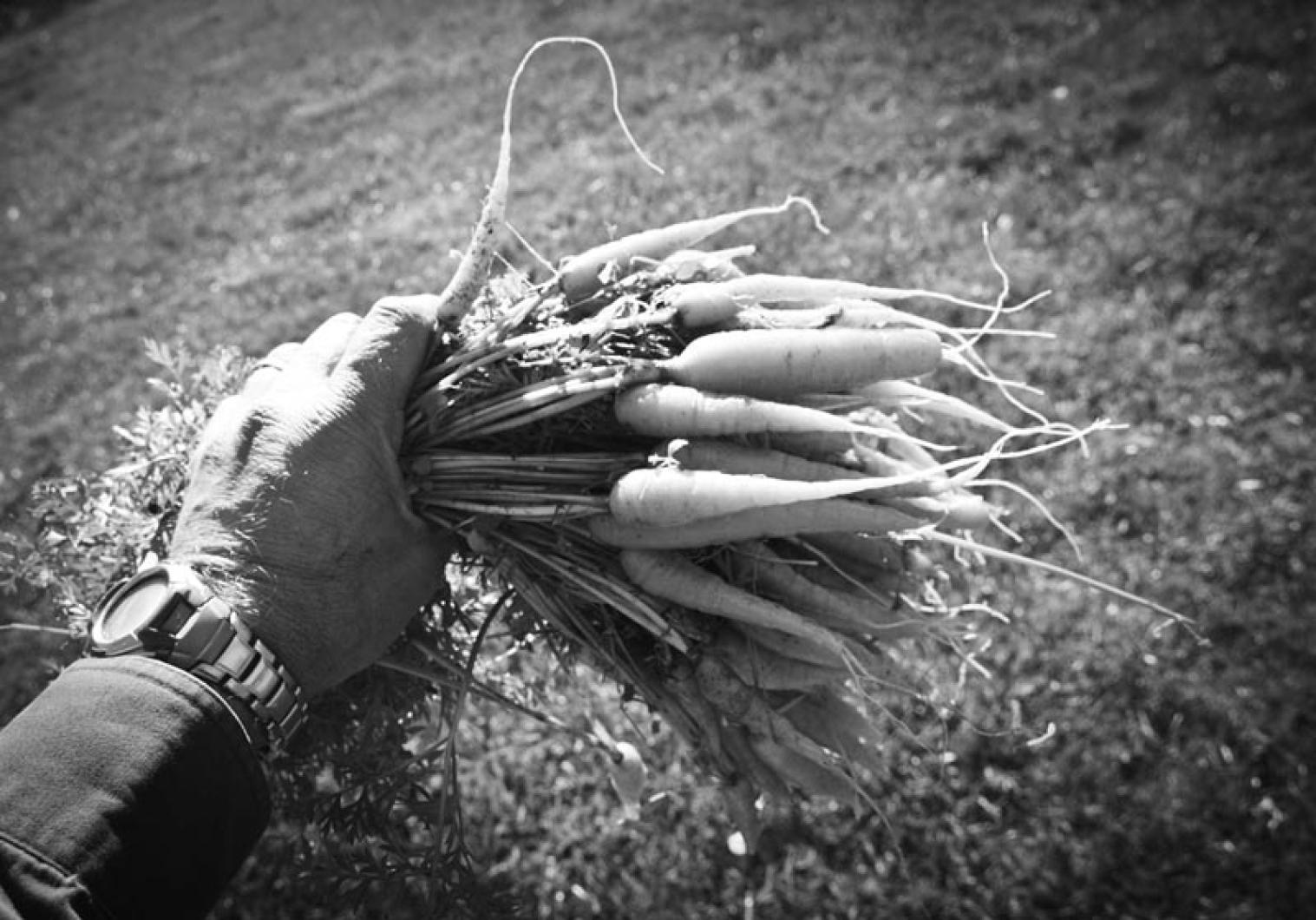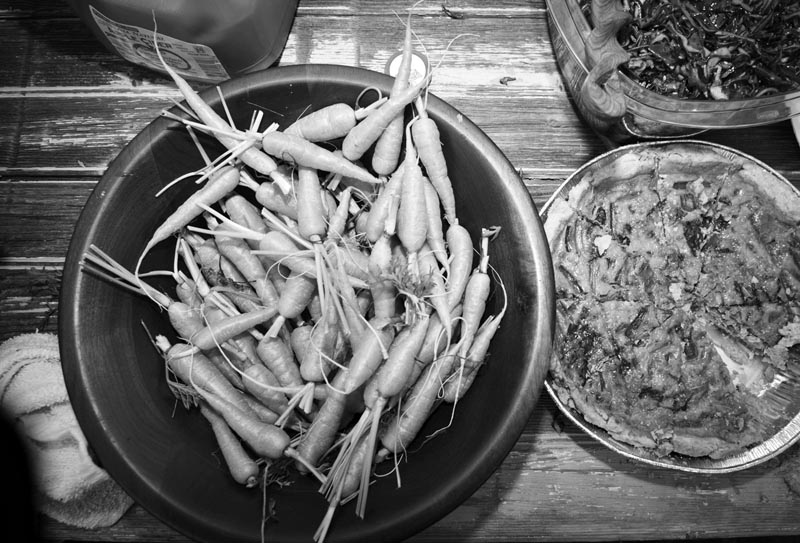When pulling carrots out of the ground these days, I am overwhelmed by their smell. I grab as many green tops as I can and yank them out of the ground, revealing many brilliant, orange magic-marker sized carrots caked with dark brown soil. The handling of the tops gives me the first tease of freshness, while the disturbance of the roots once out of the ground lures me in further, making a clean and muddy combination of aromas.
Carrots pulled late in the season are masculine and tender. I have boiled them briefly in salted water, braised them in beef stock or steamed them with nothing else added. I have roasted them in a hot oven with rosemary and sautéed them in butter and lemon. But nothing I did held a candle to eating them raw and cold from the ground. One wipe on my shirt gets enough of the grit off as I savor them while still standing in the field. This is how I have been eating them most of the time and this is how I serve them to others, after a thorough rinse in the sink. I have become paranoid that people will perceive me as uncreative or lazy in the kitchen. But eating a perfect virgin carrot is a luxury and it would be a shame to not let the ones you love experience this. Simplicity will make you happy.
Our rows of carrots sit in the back of our fields on the crest of the hill near our beehives, in a section of our cultivated land that two years ago seemed arid, rocky and unproductive. This fall the carrots are thriving. Growing carrots is not hard and most of the work is done before planting. Attention to detail makes a big difference. Carrots are slow germinators and will hide in the soil for as long as two weeks before pushing their sprouts up. Watering at least once a day is essential. Their seeds are very small and need to be planted shallowly with fine soil patted down well to ensure even contact and proper germination. The bed should be prepped in a way to break up large soil chunks and particles. If compost is used it must also be fine and well decayed, otherwise your carrots will send out uneven roots in search of food. In a perfect world, I would use a pitchfork and work into the row I intended to plant aged compost, fertilizer and soil amendments. A broad fork, a very strong tool that looks like an oversized and more sturdy rake, would be used to break up the sub soil beneath the ground. This helps the roots penetrate deeper and allows the top layer of good growing material to creep further into the earth. I would then rototill as deeply as possible and afterwards the beds would be raked level with an aluminum grading rake, leaving me with a bed ready to plant.
The carrot is a member of the Umbelliferae family — including parsley, fennel, parsnips and celeriac — and has been a staple for all growers of any sized plot for centuries due to its reliability to produce in almost any soil or climate. In the middle ages, the ancient Greeks were mad about carrots and used them widely both in their cooking and as decorations, favoring their foliage in corsages and flower arrangements.
Currently the central valley of California (stretching about 450 miles parallel to the Pacific Ocean) is the largest producer of carrots in the United States. The sun shines 300 days a year in the central valley, but their winters feel more like a hiccup from old man winter when compared to ours. Cold weather and cold soils cause carrots to store sugar in their roots; think of these carbohydrates like a down blanket for the cold season, leaving California-grown carrots lacking in sweetness compared with carrots grown in our climate and picked at this time of year.
Carrots left in the ground all winter will continue to sweeten to the point of absurdity. Already my eight year old cousin Tristen prefers them to anything else grown on the farm, including his afterschool snack packed by his mother (sorry, Lindsey.) Paul Jackson, arguably the best grower on the Island, mulches his carrots heavily with about a foot of leaves while they overwinter to insulate them from hard frosts. This simple step protects them from the elements and keeps their roots delicate and youthful, just as gardening has done for Paul himself over the years.
The first carrots, harvested in the spring after a winter in the ground, are a perfect dinner plate mate for freshly shelled peas. Already, I long for spring. I recently dreamt of a baby lamb munching on carrots as it nibbled on fennel fronds and rolled itself in mint playfully. A nice vision, but more likely an inspiration for the last lamb shoulder that sits suspended in time in my freezer.
Spring garden bounties are bright, bursts of chlorophyll and the animals are young and the fish small. But the sun rests for the night early now. A full day’s work outside has been shortened considerably. The weather has been harsh. Our gardens becoming scarce and empty. A carrot pulled this time of year will brighten your day. It transports you to spring when every day gets longer. In the spring your potential knows no limits. To survive another winter is no small feat here on the Island or anywhere else for that matter.
As I write this in front of our woodstove, I slowly feed our rabbit Richard carrots from the farm. Richard has lived its entire life outside but was tossed around a bit in the winter storm that followed Hurricane Sandy. Richard enjoys the heat of the woodstove as much as I do and slowly nibbles away, eating all the roots first and leaving the greens. Maybe Richard is saving them for a corsage?
Carrots
6 carrots per person
Walk out to your garden’s carrot row or find a farmer or neighbor who is growing them and have them escort you to their row. Bend over and pull out a handful of carrots. Wipe the first carrot clean with the bottom of your shirt or your sleeve.
Take a deep breath, inhaling the crisp fall air, and eat the carrot while taking in what surrounds you and smile. Repeat.
Recipe for Steamed Carrots with Fried Rosemary.







Comments
Comment policy »